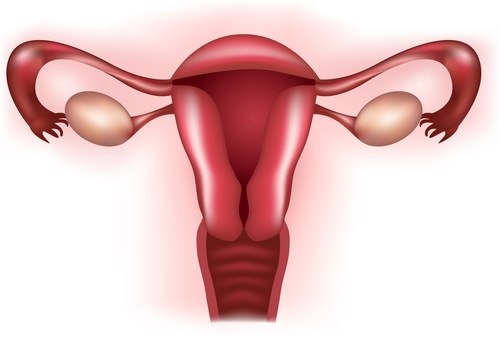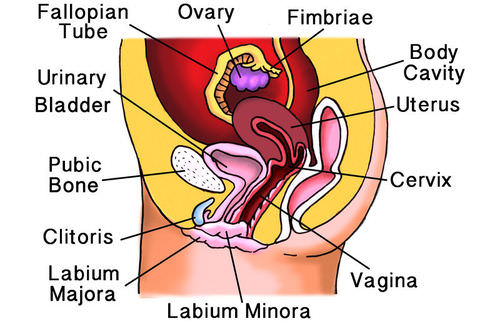13.57: Female Reproductive Organs
- Page ID
- 13332
\( \newcommand{\vecs}[1]{\overset { \scriptstyle \rightharpoonup} {\mathbf{#1}} } \)
\( \newcommand{\vecd}[1]{\overset{-\!-\!\rightharpoonup}{\vphantom{a}\smash {#1}}} \)
\( \newcommand{\dsum}{\displaystyle\sum\limits} \)
\( \newcommand{\dint}{\displaystyle\int\limits} \)
\( \newcommand{\dlim}{\displaystyle\lim\limits} \)
\( \newcommand{\id}{\mathrm{id}}\) \( \newcommand{\Span}{\mathrm{span}}\)
( \newcommand{\kernel}{\mathrm{null}\,}\) \( \newcommand{\range}{\mathrm{range}\,}\)
\( \newcommand{\RealPart}{\mathrm{Re}}\) \( \newcommand{\ImaginaryPart}{\mathrm{Im}}\)
\( \newcommand{\Argument}{\mathrm{Arg}}\) \( \newcommand{\norm}[1]{\| #1 \|}\)
\( \newcommand{\inner}[2]{\langle #1, #2 \rangle}\)
\( \newcommand{\Span}{\mathrm{span}}\)
\( \newcommand{\id}{\mathrm{id}}\)
\( \newcommand{\Span}{\mathrm{span}}\)
\( \newcommand{\kernel}{\mathrm{null}\,}\)
\( \newcommand{\range}{\mathrm{range}\,}\)
\( \newcommand{\RealPart}{\mathrm{Re}}\)
\( \newcommand{\ImaginaryPart}{\mathrm{Im}}\)
\( \newcommand{\Argument}{\mathrm{Arg}}\)
\( \newcommand{\norm}[1]{\| #1 \|}\)
\( \newcommand{\inner}[2]{\langle #1, #2 \rangle}\)
\( \newcommand{\Span}{\mathrm{span}}\) \( \newcommand{\AA}{\unicode[.8,0]{x212B}}\)
\( \newcommand{\vectorA}[1]{\vec{#1}} % arrow\)
\( \newcommand{\vectorAt}[1]{\vec{\text{#1}}} % arrow\)
\( \newcommand{\vectorB}[1]{\overset { \scriptstyle \rightharpoonup} {\mathbf{#1}} } \)
\( \newcommand{\vectorC}[1]{\textbf{#1}} \)
\( \newcommand{\vectorD}[1]{\overrightarrow{#1}} \)
\( \newcommand{\vectorDt}[1]{\overrightarrow{\text{#1}}} \)
\( \newcommand{\vectE}[1]{\overset{-\!-\!\rightharpoonup}{\vphantom{a}\smash{\mathbf {#1}}}} \)
\( \newcommand{\vecs}[1]{\overset { \scriptstyle \rightharpoonup} {\mathbf{#1}} } \)
\( \newcommand{\vecd}[1]{\overset{-\!-\!\rightharpoonup}{\vphantom{a}\smash {#1}}} \)
\(\newcommand{\avec}{\mathbf a}\) \(\newcommand{\bvec}{\mathbf b}\) \(\newcommand{\cvec}{\mathbf c}\) \(\newcommand{\dvec}{\mathbf d}\) \(\newcommand{\dtil}{\widetilde{\mathbf d}}\) \(\newcommand{\evec}{\mathbf e}\) \(\newcommand{\fvec}{\mathbf f}\) \(\newcommand{\nvec}{\mathbf n}\) \(\newcommand{\pvec}{\mathbf p}\) \(\newcommand{\qvec}{\mathbf q}\) \(\newcommand{\svec}{\mathbf s}\) \(\newcommand{\tvec}{\mathbf t}\) \(\newcommand{\uvec}{\mathbf u}\) \(\newcommand{\vvec}{\mathbf v}\) \(\newcommand{\wvec}{\mathbf w}\) \(\newcommand{\xvec}{\mathbf x}\) \(\newcommand{\yvec}{\mathbf y}\) \(\newcommand{\zvec}{\mathbf z}\) \(\newcommand{\rvec}{\mathbf r}\) \(\newcommand{\mvec}{\mathbf m}\) \(\newcommand{\zerovec}{\mathbf 0}\) \(\newcommand{\onevec}{\mathbf 1}\) \(\newcommand{\real}{\mathbb R}\) \(\newcommand{\twovec}[2]{\left[\begin{array}{r}#1 \\ #2 \end{array}\right]}\) \(\newcommand{\ctwovec}[2]{\left[\begin{array}{c}#1 \\ #2 \end{array}\right]}\) \(\newcommand{\threevec}[3]{\left[\begin{array}{r}#1 \\ #2 \\ #3 \end{array}\right]}\) \(\newcommand{\cthreevec}[3]{\left[\begin{array}{c}#1 \\ #2 \\ #3 \end{array}\right]}\) \(\newcommand{\fourvec}[4]{\left[\begin{array}{r}#1 \\ #2 \\ #3 \\ #4 \end{array}\right]}\) \(\newcommand{\cfourvec}[4]{\left[\begin{array}{c}#1 \\ #2 \\ #3 \\ #4 \end{array}\right]}\) \(\newcommand{\fivevec}[5]{\left[\begin{array}{r}#1 \\ #2 \\ #3 \\ #4 \\ #5 \\ \end{array}\right]}\) \(\newcommand{\cfivevec}[5]{\left[\begin{array}{c}#1 \\ #2 \\ #3 \\ #4 \\ #5 \\ \end{array}\right]}\) \(\newcommand{\mattwo}[4]{\left[\begin{array}{rr}#1 \amp #2 \\ #3 \amp #4 \\ \end{array}\right]}\) \(\newcommand{\laspan}[1]{\text{Span}\{#1\}}\) \(\newcommand{\bcal}{\cal B}\) \(\newcommand{\ccal}{\cal C}\) \(\newcommand{\scal}{\cal S}\) \(\newcommand{\wcal}{\cal W}\) \(\newcommand{\ecal}{\cal E}\) \(\newcommand{\coords}[2]{\left\{#1\right\}_{#2}}\) \(\newcommand{\gray}[1]{\color{gray}{#1}}\) \(\newcommand{\lgray}[1]{\color{lightgray}{#1}}\) \(\newcommand{\rank}{\operatorname{rank}}\) \(\newcommand{\row}{\text{Row}}\) \(\newcommand{\col}{\text{Col}}\) \(\renewcommand{\row}{\text{Row}}\) \(\newcommand{\nul}{\text{Nul}}\) \(\newcommand{\var}{\text{Var}}\) \(\newcommand{\corr}{\text{corr}}\) \(\newcommand{\len}[1]{\left|#1\right|}\) \(\newcommand{\bbar}{\overline{\bvec}}\) \(\newcommand{\bhat}{\widehat{\bvec}}\) \(\newcommand{\bperp}{\bvec^\perp}\) \(\newcommand{\xhat}{\widehat{\xvec}}\) \(\newcommand{\vhat}{\widehat{\vvec}}\) \(\newcommand{\uhat}{\widehat{\uvec}}\) \(\newcommand{\what}{\widehat{\wvec}}\) \(\newcommand{\Sighat}{\widehat{\Sigma}}\) \(\newcommand{\lt}{<}\) \(\newcommand{\gt}{>}\) \(\newcommand{\amp}{&}\) \(\definecolor{fillinmathshade}{gray}{0.9}\)
Think producing millions of sperm each day is complicated?
If producing millions of sperm each day, as in the male reproductive system, is complicated, that is nothing compared to what must occur in the female reproductive system. This system is controlled by an intricate dance of hormones, cycles, and events.
Female Reproductive Structures
The female reproductive system consists of structures that produce female gametes called eggs and secrete the female sex hormone estrogen. The female reproductive system has several other functions as well:
- It receives sperm during sexual intercourse.
- It supports the development of a fetus.
- It delivers a baby during birth.
- It breast feeds a baby after birth.
The main structures of the female reproductive system are shown in Figure below. Most of the structures are inside the pelvic region of the body. Locate the structures in the figure as you read about them below.
 Female Reproductive Structures. Organs of the female reproductive system include the vagina, uterus, ovaries, and fallopian tubes.
Female Reproductive Structures. Organs of the female reproductive system include the vagina, uterus, ovaries, and fallopian tubes.External Structures
The external female reproductive structures are referred to collectively as the vulva. They include the labia (singular, labium), which are the “lips” of the vulva. The labia protect the vagina and urethra, both of which have openings in the vulva.
Vagina
The vagina is a tube-like structure about 9 centimeters (3.5 inches) long. It begins at the vulva and extends upward to the uterus. It has muscular walls lined with mucous membranes. The vagina has two major reproductive functions. It receives sperm during sexual intercourse, and it provides a passageway for a baby to leave the mother’s body during birth.
Uterus
The uterus is a muscular organ shaped like an upside-down pear. It has a thick lining of tissues called the endometrium. The lower, narrower end of the uterus is known as the cervix. The uterus is where a fetus grows and develops until birth. During pregnancy, the uterus can expand greatly to make room for the baby as it grows. During birth, contractions of the muscular walls of the uterus push the baby through the cervix and out of the body.
Ovaries
The two ovaries are small, egg-shaped organs that lie on either side of the uterus. They produce eggs and secrete estrogen. Each egg is located inside a structure called a follicle. Cells in the follicle protect the egg and help it mature.
Fallopian Tubes
Extending from the upper corners of the uterus are the two fallopian tubes. Each tube reaches (but is not attached to) one of the ovaries. The ovary end of the tube has a fringelike structure that moves in waves. The motion sweeps eggs from the ovary into the tube.
Breasts
The breasts are not directly involved in reproduction, but they nourish a baby after birth. Each breast contains mammary glands, which secrete milk. The milk drains into ducts leading to the nipple. A suckling baby squeezes the milk out of the ducts and through the nipple.
Summary
- The female reproductive system consists of structures that produce eggs and secrete female sex hormones. They also provide a site for fertilization and enable the development and birth of a fetus.
- Female reproductive structures include the vagina, uterus, ovaries, and fallopian tubes.
Review
- List three general functions of the female reproductive system.
- Describe the uterus, and state its role in reproduction.
- What are the roles of the ovaries and the follicles?
- What are the fallopian tubes?
| Image | Reference | Attributions |
 |
[Figure 1] | Credit: Laura Guerin Source: CK-12 Foundation License: CC BY-NC |
 |
[Figure 2] | Credit: Laura Guerin Source: CK-12 Foundation License: CC BY-NC 3.0 |

